Abstract
In order to evaluate the prevalence and multiple risk factors of arsenic-induced skin cancer among residents in Taiwanese villages in which chronic arseniasis is hyperendemic, a total of 1571 subjects aged 30 or more years were recruited between September 1988 and March 1989. All of them were interviewed personally by a public health nurse using a structured questionnaire, and 1081 interviewed study subjects, including 468 men and 613 women, participated in physical examination, giving a participation rate of 68.8%. The overall prevalence of skin cancer was as high as 6.1%, showing an increase with age in both men and women. There was a significant dose-response relation between skin cancer prevalence and chronic arsenic exposure as indexed by duration of residence in the endemic area, duration of consumption of high-arsenic artesian well water, average arsenic exposure in parts per million (p.p.m.) and cumulative arsenic exposure in p.p.m.-years. Chronic carriers of hepatitis B surface antigen with liver dysfunction had an increased prevalence of skin cancer. Undernourishment, indexed by a high consumption of dried sweet potato as a staple food, was also significantly associated with an increased prevalence of arsenic-induced skin cancer. All these risk factors remained statistically significant in the multiple logistic regression analysis. Consistent with animal experiments, the findings imply that liver function and nutritional status may affect the metabolism of inorganic arsenic and the development of subsequent skin cancers.
Full text
PDF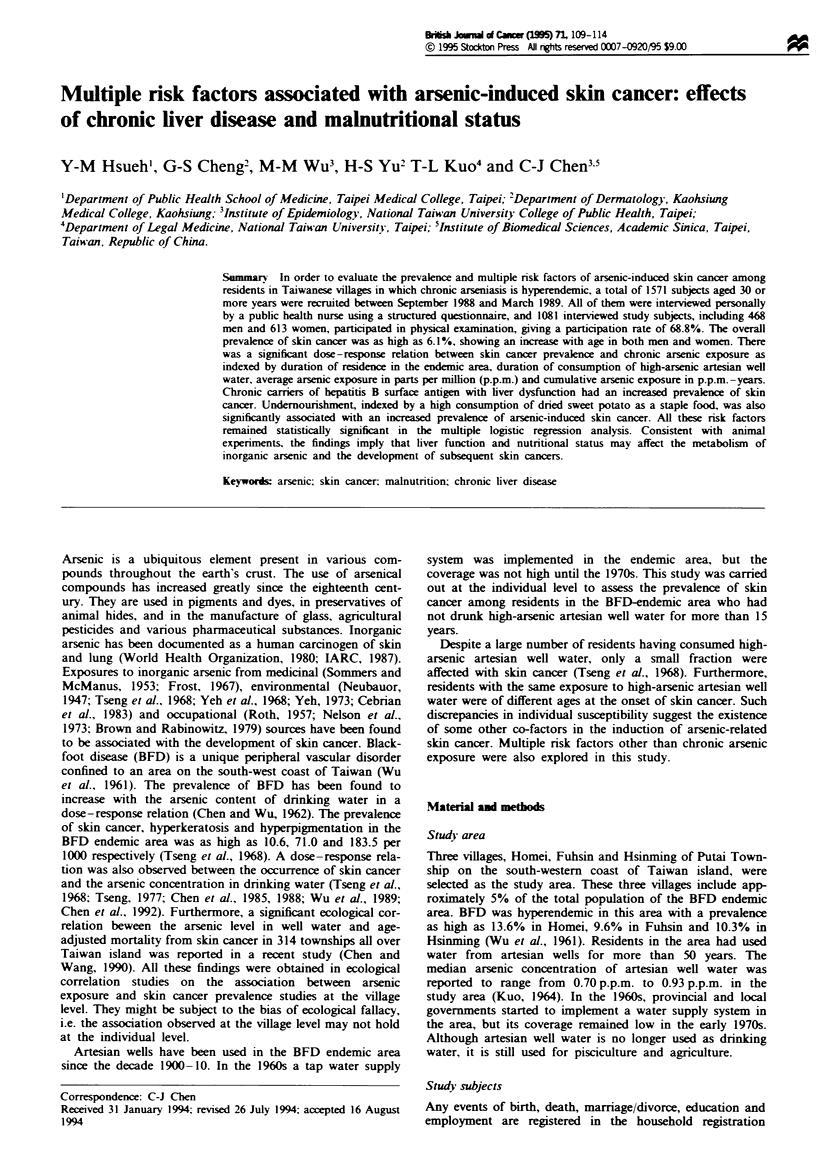
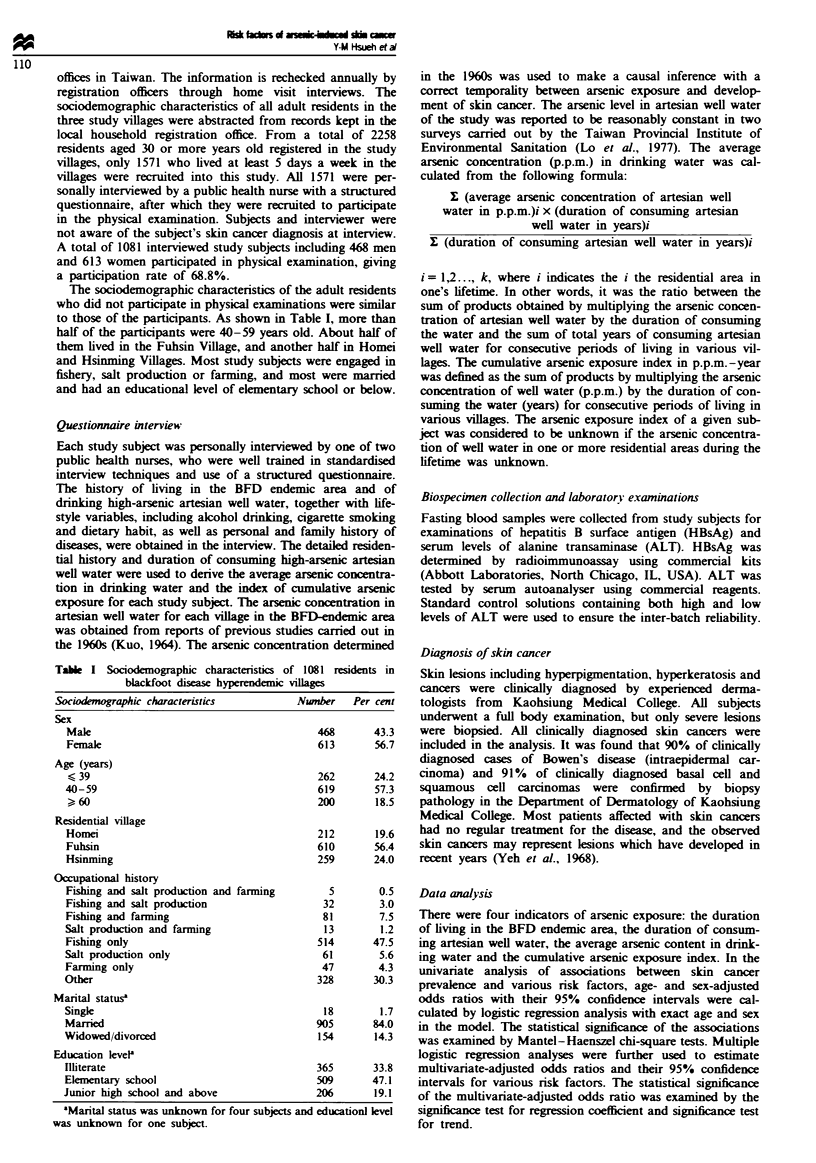
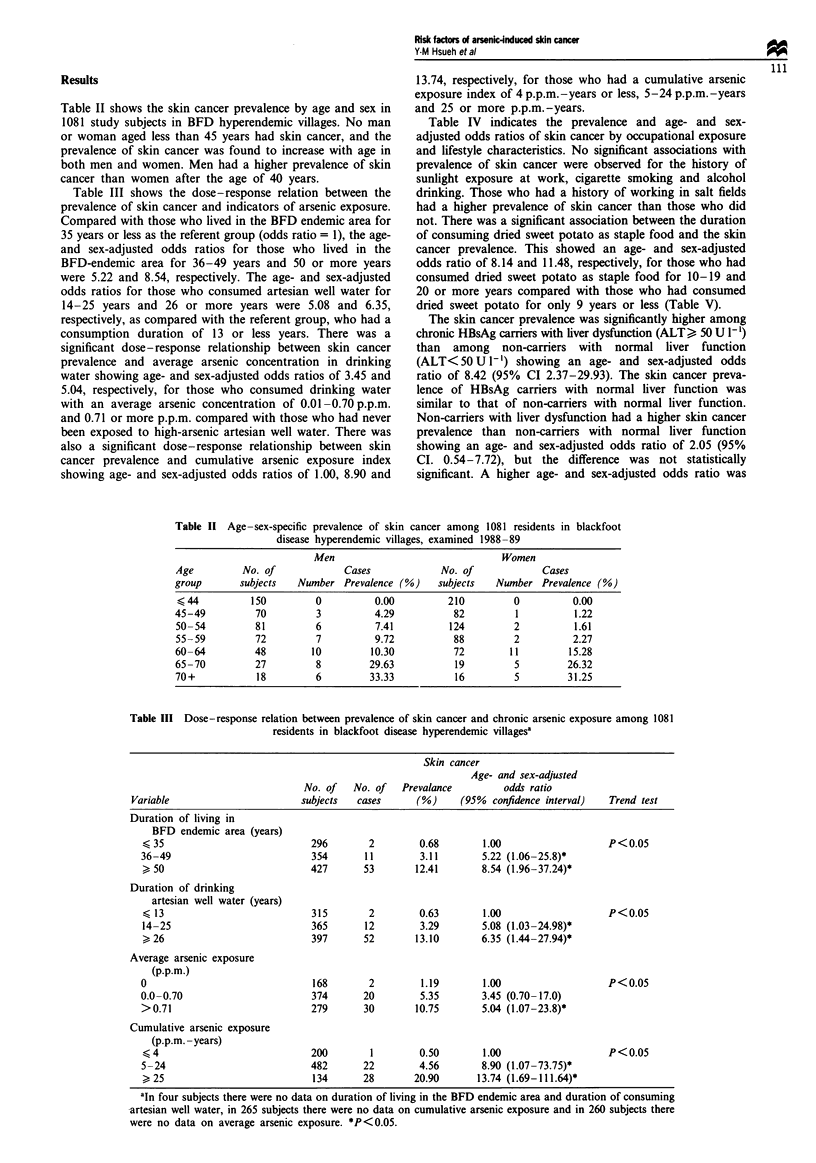
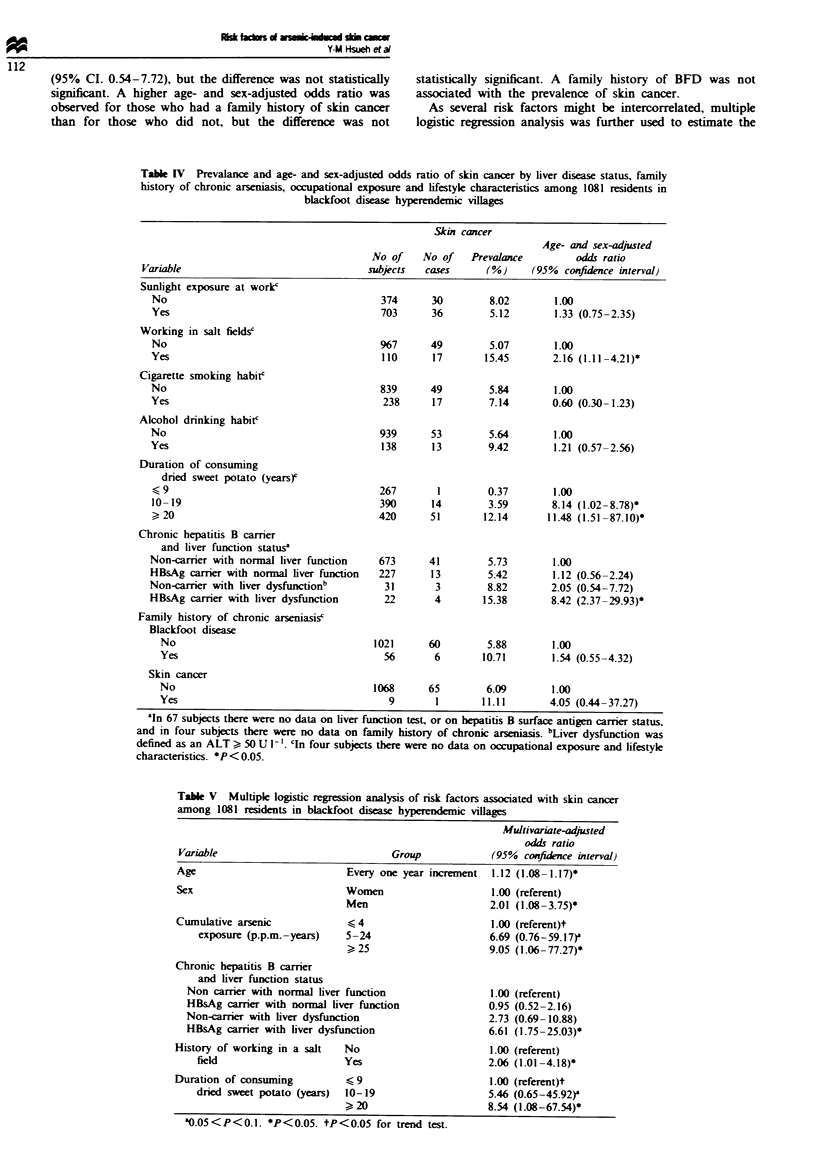
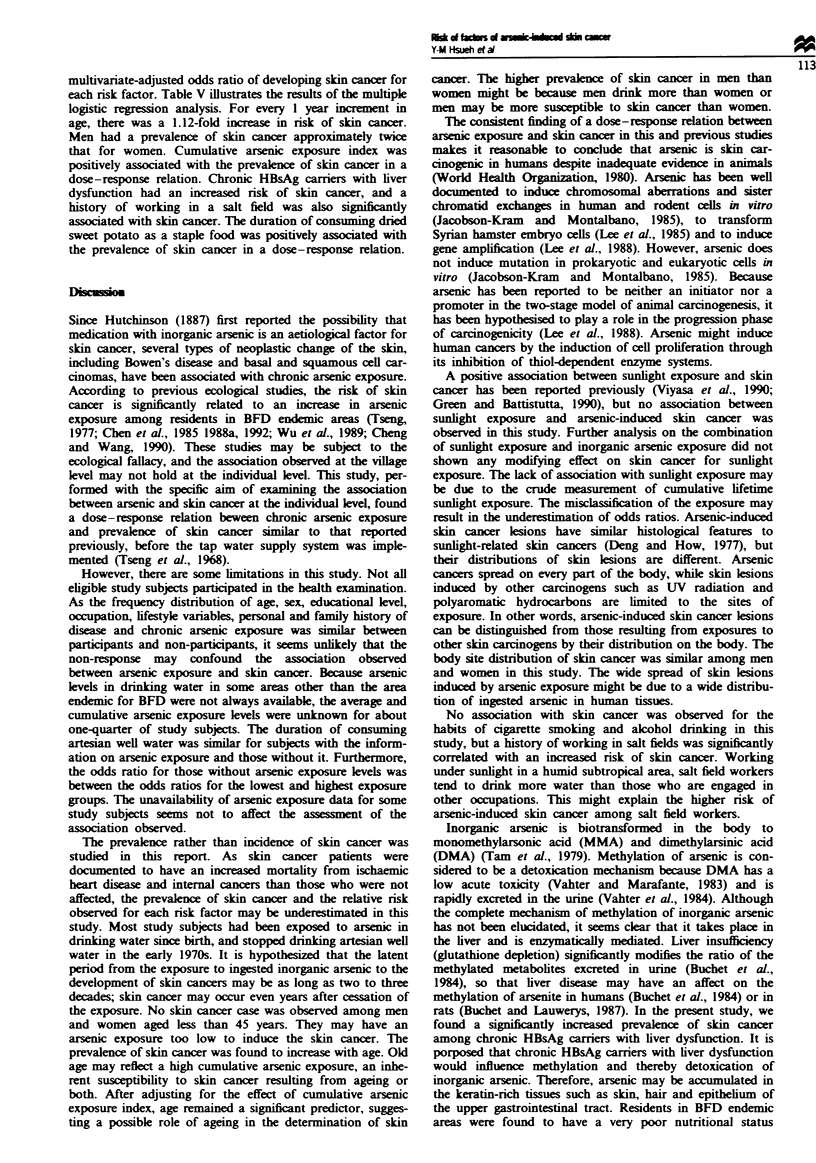
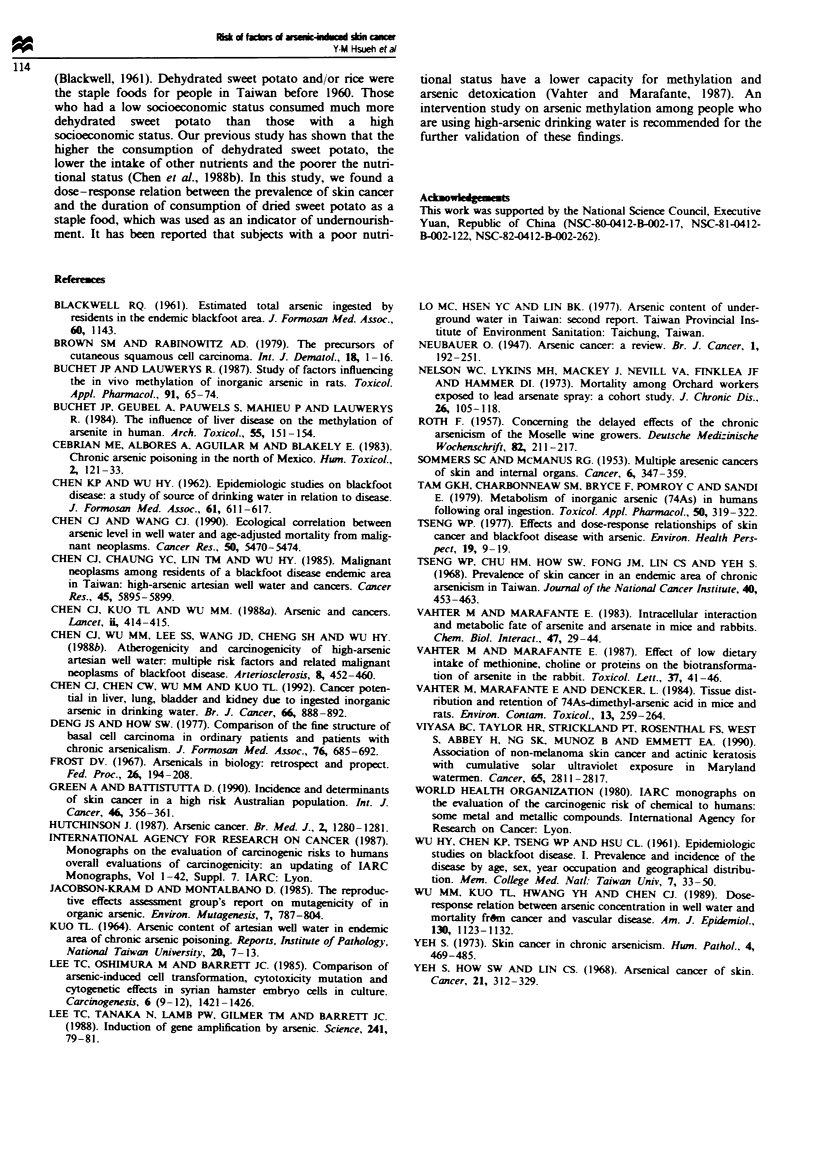
Selected References
These references are in PubMed. This may not be the complete list of references from this article.
- Brownstein M. H., Rabinowitz A. D. The precursors of cutaneous squamous cell carcinoma. Int J Dermatol. 1979 Jan-Feb;18(1):1–16. doi: 10.1111/j.1365-4362.1979.tb01903.x. [DOI] [PubMed] [Google Scholar]
- Buchet J. P., Geubel A., Pauwels S., Mahieu P., Lauwerys R. The influence of liver disease on the methylation of arsenite in humans. Arch Toxicol. 1984 Sep;55(3):151–154. doi: 10.1007/BF00316119. [DOI] [PubMed] [Google Scholar]
- Buchet J. P., Lauwerys R. Study of factors influencing the in vivo methylation of inorganic arsenic in rats. Toxicol Appl Pharmacol. 1987 Oct;91(1):65–74. doi: 10.1016/0041-008x(87)90194-3. [DOI] [PubMed] [Google Scholar]
- Cebrián M. E., Albores A., Aguilar M., Blakely E. Chronic arsenic poisoning in the north of Mexico. Hum Toxicol. 1983 Jan;2(1):121–133. doi: 10.1177/096032718300200110. [DOI] [PubMed] [Google Scholar]
- Chen C. J., Chen C. W., Wu M. M., Kuo T. L. Cancer potential in liver, lung, bladder and kidney due to ingested inorganic arsenic in drinking water. Br J Cancer. 1992 Nov;66(5):888–892. doi: 10.1038/bjc.1992.380. [DOI] [PMC free article] [PubMed] [Google Scholar]
- Chen C. J., Chuang Y. C., Lin T. M., Wu H. Y. Malignant neoplasms among residents of a blackfoot disease-endemic area in Taiwan: high-arsenic artesian well water and cancers. Cancer Res. 1985 Nov;45(11 Pt 2):5895–5899. [PubMed] [Google Scholar]
- Chen C. J., Wu M. M., Lee S. S., Wang J. D., Cheng S. H., Wu H. Y. Atherogenicity and carcinogenicity of high-arsenic artesian well water. Multiple risk factors and related malignant neoplasms of blackfoot disease. Arteriosclerosis. 1988 Sep-Oct;8(5):452–460. doi: 10.1161/01.atv.8.5.452. [DOI] [PubMed] [Google Scholar]
- Deng J. S., How S. W. Comparison of the fine structure of basal cell carcinomas in ordinary patients and patients with chronic arsenicalism. Taiwan Yi Xue Hui Za Zhi. 1977 Sep;76(9):685–692. [PubMed] [Google Scholar]
- Frost D. V. Arsenicals in biology--retrospect and prospect. Fed Proc. 1967 Jan-Feb;26(1):194–208. [PubMed] [Google Scholar]
- Green A., Battistutta D. Incidence and determinants of skin cancer in a high-risk Australian population. Int J Cancer. 1990 Sep 15;46(3):356–361. doi: 10.1002/ijc.2910460303. [DOI] [PubMed] [Google Scholar]
- Jacobson-Kram D., Montalbano D. The reproductive effects assessment group's report on the mutagenicity of inorganic arsenic. Environ Mutagen. 1985;7(5):787–804. doi: 10.1002/em.2860070515. [DOI] [PubMed] [Google Scholar]
- Lee T. C., Oshimura M., Barrett J. C. Comparison of arsenic-induced cell transformation, cytotoxicity, mutation and cytogenetic effects in Syrian hamster embryo cells in culture. Carcinogenesis. 1985 Oct;6(10):1421–1426. doi: 10.1093/carcin/6.10.1421. [DOI] [PubMed] [Google Scholar]
- Lee T. C., Tanaka N., Lamb P. W., Gilmer T. M., Barrett J. C. Induction of gene amplification by arsenic. Science. 1988 Jul 1;241(4861):79–81. doi: 10.1126/science.3388020. [DOI] [PubMed] [Google Scholar]
- Nelson W. C., Lykins M. H., Mackey J., Newill V. A., Finklea J. F., Hammer D. I. Mortality among orchard workers exposed to lead arsenate spray: a cohort study. J Chronic Dis. 1973 Feb;26(2):105–118. doi: 10.1016/0021-9681(73)90009-x. [DOI] [PubMed] [Google Scholar]
- SOMMERS S. C., MCMANUS R. G. Multiple arsenical cancers of skin and internal organs. Cancer. 1953 Mar;6(2):347–359. doi: 10.1002/1097-0142(195303)6:2<347::aid-cncr2820060219>3.0.co;2-l. [DOI] [PubMed] [Google Scholar]
- Tam G. K., Charbonneau S. M., Bryce F., Pomroy C., Sandi E. Metabolism of inorganic arsenic (74As) in humans following oral ingestion. Toxicol Appl Pharmacol. 1979 Sep 15;50(2):319–322. doi: 10.1016/0041-008x(79)90157-1. [DOI] [PubMed] [Google Scholar]
- Tseng W. P., Chu H. M., How S. W., Fong J. M., Lin C. S., Yeh S. Prevalence of skin cancer in an endemic area of chronic arsenicism in Taiwan. J Natl Cancer Inst. 1968 Mar;40(3):453–463. [PubMed] [Google Scholar]
- Vahter M., Marafante E., Dencker L. Tissue distribution and retention of 74As-dimethylarsinic acid in mice and rats. Arch Environ Contam Toxicol. 1984 May;13(3):259–264. doi: 10.1007/BF01055275. [DOI] [PubMed] [Google Scholar]
- Vahter M., Marafante E. Effects of low dietary intake of methionine, choline or proteins on the biotransformation of arsenite in the rabbit. Toxicol Lett. 1987 Jun;37(1):41–46. doi: 10.1016/0378-4274(87)90165-2. [DOI] [PubMed] [Google Scholar]
- Vahter M., Marafante E. Intracellular interaction and metabolic fate of arsenite and arsenate in mice and rabbits. Chem Biol Interact. 1983 Oct 15;47(1):29–44. doi: 10.1016/0009-2797(83)90145-x. [DOI] [PubMed] [Google Scholar]
- Vitasa B. C., Taylor H. R., Strickland P. T., Rosenthal F. S., West S., Abbey H., Ng S. K., Munoz B., Emmett E. A. Association of nonmelanoma skin cancer and actinic keratosis with cumulative solar ultraviolet exposure in Maryland watermen. Cancer. 1990 Jun 15;65(12):2811–2817. doi: 10.1002/1097-0142(19900615)65:12<2811::aid-cncr2820651234>3.0.co;2-u. [DOI] [PubMed] [Google Scholar]
- Wu M. M., Kuo T. L., Hwang Y. H., Chen C. J. Dose-response relation between arsenic concentration in well water and mortality from cancers and vascular diseases. Am J Epidemiol. 1989 Dec;130(6):1123–1132. doi: 10.1093/oxfordjournals.aje.a115439. [DOI] [PubMed] [Google Scholar]
- Yeh S., How S. W., Lin C. S. Arsenical cancer of skin. Histologic study with special reference to Bowen's disease. Cancer. 1968 Feb;21(2):312–339. doi: 10.1002/1097-0142(196802)21:2<312::aid-cncr2820210222>3.0.co;2-k. [DOI] [PubMed] [Google Scholar]
- Yeh S. Skin cancer in chronic arsenicism. Hum Pathol. 1973 Dec;4(4):469–485. doi: 10.1016/s0046-8177(73)80060-7. [DOI] [PubMed] [Google Scholar]


